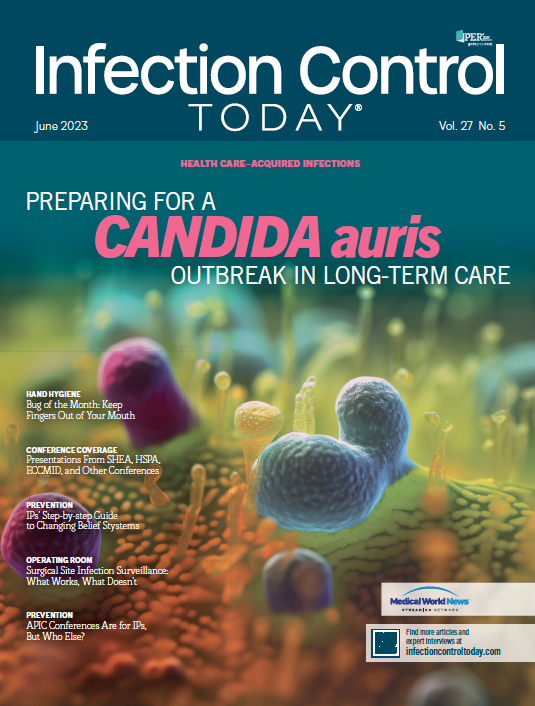For decades, long-term care facilities have experienced many outbreaks, pandemics, and epidemics, including scabies, severe acute respiratory syndrome (SARS), H1N1 influenza, seasonal influenza, norovirus, and multidrug-resistant organisms (MDROs) such as methicillin-resistant Staphylococcus aureus (MRSA), carbapenem-resistant Enterobacterales (CRE), and extended-spectrum β-lactamases. Although we have all been dealing with COVID-19 and its many variants, a new threat of a fungal infection, Candida auris, is showing itself. The health care industry knew of C auris before COVID-19. Still, many health and long-term care facilities were not watching C auris closely enough during the pandemic. Now we are getting information about missed outbreaks caused by C auris.1
People who get invasive Candida infections are often already sick from other comorbidities, so it can be challenging to know whether they have a C auris infection. The most common symptoms of invasive Candida infection are fever and chills that do not improve after antibiotic treatment for a suspected bacterial infection.2,3,4 Only a laboratory test can diagnose C auris infection.2
C auris can cause serious infections such as bloodstream infections and other invasive types of infection in individuals with many medical problems. Over 1 in 3 patients dies within a month of receiving a diagnosis of an invasive C auris infection. It is likely multidrug-resistant, meaning antifungal medications used to treat other Candida2,4 infections do not work for C auris. Some C auris isolates resist all 3 major classes of antifungal medications.5
C auris was discovered in 2009 and the number of cases has proliferated.2,4 Another concern is that it is difficult to identify. This fungus can be easily misidentified as another type of fungus if the laboratory does not have a specialized method to identify C auris correctly. So the long-term care facility must verify whether the laboratory it contracts with can identify C auris. If not, what is the process for identifying it?
Some laboratories will send specimens to state laboratories or to the CDC to get identification of the type of Candida that may be circulating within your community and in hospitals and nursing homes in your area. How your lab does this should be a top priority because you can prevent an outbreak only if the culprit is being looked for. Like other multidrug-resistant organisms such as CRE or MRSA, C auris can be transmitted within nursing homes and cause outbreaks. It can also colonize residents for months, live on environmental surfaces, and survive many hospital-approved disinfectants.2 It is crucial to clean the resident care environment using a disinfectant with an Environmental Protection Agency claim for C auris or, if not available, for Clostridioides difficile.2,3 Some disinfectants may not be effective against C auris, despite claims of effectiveness against Candida albicans or other fungi.2
Another way to prevent a C auris outbreak is to ask the health care facility transferring a resident to your facility whether the resident has a history of C auris or any other MDRO. If residents are colonized at admission, the sending facility might not share that with you if they are not asked. You must know whether residents have ever been colonized or infected with C auris or any other MDRO because colonized residents can spread C auris to other residents, who may become infected. Colonized and infected residents can lead to an outbreak within your nursing home. Colonization means that a resident has had fungus somewhere on their body but does not have an infection or symptoms of an infection. Being infected means that the resident has symptoms and is ill from the fungus, and they need to be treated and monitored closely.
What to do in an outbreak?
- What happens if you find you are in an outbreak situation? An outbreak is the occurrence of more disease cases than expected in a given area or among a specific group of people over a particular period. Because C auris should not be found in a long-term care facility, 1 positive culture would be considered an outbreak.3,4 At this point, you must go into outbreak mode.
- Pull out your policy and implement it. Begin to complete the local and state outbreak information forms.
- Notify your local or state epidemiology office.
- Because C auris is carried on the skin, the best way to test is to swab inside the resident’s armpit and groin and the area where C auris was initially identified. (Getting culture results back may take 1 to 2 weeks, so standard and contact precautions are essential.)
- Immediately place the identified resident in a private room on contact precautions. If you do not have a private room, you may be advised to leave the resident in their original space and do cultures on roommates to determine if they have been colonized. You should consider whether you need an expert opinion from your medical director, IP consultant, local or state epidemiology department within the DOH, or other professionals.
- The best way to prevent and control an infection outbreak is to be prepared. A strong IP program can prevent and limit any outbreak situation, saving costs and loss of lives.
It is also important that your facility infection preventionist talk to your local or state epidemiology department (not the licensing branch) to find out what the local or state regulations are for C auris. Some may want the resident to be in a private room and cared for by only 1 nurse; others may require that their staff come into the facility to review the residents’ records and guide you. Most epidemiology branches of your local or state department of health will have their own outbreak forms they will want you to use, update daily, fax, or email every day.
- Ask: Did the resident have C auris colonized or infected before transfer? It is essential that the person screening admissions to your facility ask whether the admitted person has a history of C auris.
- Monitor all culture results daily for any evidence of C auris. Ask your lab to notify you by phone if C auris is identified.
- Your facility infection preventionist should educate themselves on all information related to C auris. If that is not possible, hire an IP consultant to help identify your opportunities for improvement to strengthen your IP program and assist your inhouse–designated infection preventionist.
- Ask your local or state epidemiology office (not the Centers for Medicare & Medicaid Services licensing branch) what they require if you find a positive C auris culture. What forms do they require you to complete, and how often do you report information to them? Write a policy containing all this information with contact people and phone numbers within the epidemiology branch. Make sure the team knows about this information and where to find it.
- Develop a policy outlining what to do if a resident receives a diagnosis of C auris. It is a good idea to have all departments take part in the discussion on policy development.
- Where will the resident be placed, in a private room or in their current room?
- If they have roommates at the diagnosis, is the roommate cultured to see whether they have been colonized? Check for colonization by swabbing the armpits and groin.
- Do not admit to empty beds in the room if the resident is left in their current room.
- Designate patient care equipment only for the resident who has C auris.
- Determine what your procedure will be to identify how the resident became infected (ie, by a colonized roommate, were they admitted colonized, could staff or visitors be the source?). It is important to find the source so the outbreak can be contained to as few residents as possible.
- There is no need for paper plates or plastic flatware. To clean the fungus off tableware, all kitchens should be disinfected at the proper temperature and detergent.
- Educate your employees about C auris.
- Educate, monitor, and enforce reasonable standard precautions with all residents. Correct staff when breaks in standard precautions are identified. Performing proper standard precautions at all times can limit the spread of C auris if it is circulating unidentified within your facility.
- Educate, encourage, monitor compliance, and correct noncompliance for proper hand hygiene for staff, visitors, and residents.
- Identify what disinfectant you need to clean the environment, ie, rooms where residents are colonized or infected with C auris.2
- Identify any breaks of environmental cleaning, ie, replace torn mattresses and chairs and surfaces that are no longer cleanable because the surface is worn off, ensure proper cleaning and maintenance of all shared medical equipment within the facility, etc.
- Once your policy is completed, consider asking your local epidemiology branch of the Department of Health to review it and see whether they think anything should be added.
References:
- Fungal diseases and COVID-19. Centers for Disease Control and Prevention. March 2, 2022. Accessed April 21, 2023. https://www.cdc.gov/fungal/covid-fungal.html
- Candida auris: a drug-resistant germ that spreads in healthcare facilities. Centers for Disease Control and Prevention. April 5, 2023. Accessed April 21, 2023. https://www.cdc.gov/fungal/candida-auris/c-auris-drug-resistant.html
- Candida auris. Centers for Disease Control and Prevention. April 7, 2023. Accessed April 21, 2023. https://www.cdc.gov/fungal/candida-auris/index.html
- Outbreak investigations in health care settings. Centers for Disease Control and Prevention. February 1, 2023. Accessed April 21, 2023. https://www.cdc.gov/hai/outbreaks/index.html
- Ostrowsky B, Greenko J, Adams E, et al. Candida auris isolates resistant to three classes of antifungal medications - New York, 2019. MMWR Morb Mortal Wkly Rep. 2020;69(1):6-9. doi:10.15585/mmwr.mm6901a2

